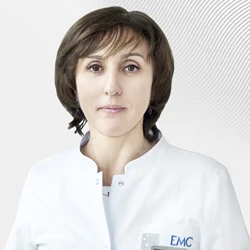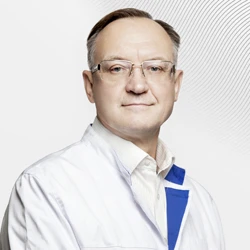Prostate cancer
 Prostate cancer is one of the most common cancers in men. Its danger lies in the fact that there are practically no symptoms in the initial stages. Due to the lack of timely diagnosis, many patients begin treatment late, when the tumor has already spread to other organs and has given distant metastases.
Prostate cancer is one of the most common cancers in men. Its danger lies in the fact that there are practically no symptoms in the initial stages. Due to the lack of timely diagnosis, many patients begin treatment late, when the tumor has already spread to other organs and has given distant metastases.
What is prostate cancer
Prostate cancer is a malignant neoplasm that develops from the secretory epithelium of the prostate gland. As with other oncological diseases, a tumor occurs due to atypical cells that divide pathologically quickly and form a neoplasm.
Prostate cancer is often diagnosed at late stages. Only a small proportion of men undergo special screening, so it is difficult to detect a tumor at the initial stage.
Causes and risk factors
It is not yet known for certain what exactly causes the development of the tumor. But scientists have already identified risk factors that increase the likelihood of getting sick.:
Age. The older the man, the higher the risks.
Race. The disease is more often diagnosed in representatives of the black race.
Hereditary predisposition. The risk group includes men whose close relatives had prostate cancer.
Harmful working conditions (for example, radiation exposure to pilots or interaction with chemicals in factories).
Smoking, alcohol consumption (especially strong alcohol).
Improper diet (with a lot of animal fats in the diet).
A history of diseases of the genitourinary system (prostatitis, prostatic hyperplasia).
The disease is most often diagnosed in men over the age of 60, but in recent years there has been a tendency to "rejuvenate" the pathology.
Symptoms
Prostate cancer in its early stages has no obvious symptoms. The disease develops slowly enough, so the patient may not be aware of it for several years. As the tumor grows, some noticeable symptoms appear:frequent urination, especially at night;
difficulty urinating;
urinary incontinence;
weak or intermittent urine flow;
pain or burning during urination;
blood in urine or semen.
In some cases, prostate cancer can also lead to bone pain, especially in the pelvis, back, chest, or upper extremities. The symptoms are non-specific, so they can easily be confused with signs of other diseases.
Classification
Prostate cancer is classified by stage according to the international TNM system, which takes into account the size of the primary tumor, damage to the lymph nodes and distant metastases:Stage 1. Cancer cells are localized in the prostate. There are no symptoms of the disease.
Stage 2. Cancer cells are also found in the prostate. The tumor can be felt.
Stage 3. The tumor spreads to neighboring organs and seminal vesicles.
Stage 4. Cancer spreads rapidly and aggressively to distant organs. Metastases appear in bones, liver, lungs, brain, etc.
Accurate classification of prostate cancer helps oncologists determine treatment strategies and predict the course of the disease.
Cancer diagnosis
Since prostate cancer does not manifest itself in the early stages, preventive examinations are of key importance in diagnosis. Even if the patient does not experience any symptoms, the urologist can already assume the diagnosis and conduct an examination based on clinical signs. The first thing you usually start with is a finger rectal examination of the prostate gland. The prostate is located on the front surface of the rectum, so the doctor can feel the seals.
On palpation, the posterior surface of the prostate is well accessible, but the pathological formations in its anterior and upper parts are less palpable. Therefore, no diagnosis is made based on this method of cancer diagnosis alone. If there is suspicion, the doctor prescribes additional examinations.:
Analysis to determine the PSA level. Prostate specific antigen is a marker that is elevated due to certain prostate diseases, including cancer.
Ultrasound examination. A safe and effective procedure that allows you to visualize the prostate using ultrasound waves. Ultrasound is necessary to determine the size, shape and structure of the organ tissues.
Biopsy. A procedure in which a sample of prostate tissue is taken using a special needle for further examination under a microscope. A biopsy is an important method for diagnosing prostate cancer and determining its degree of aggressiveness.
Radionuclide research. The method uses radioactive substances that are injected into the body and then detected by special devices. Radionuclide testing, such as scintigraphy or positron emission tomography (PET), helps to detect metastases or determine the spread of prostate cancer beyond its borders.
Magnetic resonance imaging (MRI). The method uses magnetic fields and radio waves to create detailed images of internal organs and tissues. MRI allows you to more accurately determine the size and location of the tumor, as well as assess its spread to surrounding structures.
The EMC clinic also uses a unique fusion biopsy technique. This is the collection of a tissue sample under visual control using a complex of MRI and ultrasound. In prostate cancer, the pathological focus is difficult to access, so a standard biopsy is not effective enough. Targeted sampling from suspicious sites is much more revealing. This method is 30% more accurate.
Treatment
The EMC clinic uses an integrated approach to the treatment of prostate cancer, including various methods depending on the stage of the disease, the patient's medical history and his personal wishes. There are many strategies: this is a wait-and-see tactic, surgery, or the destruction of a tumor using various influences.
A wait−and-see tactic is constant monitoring without therapeutic effects. Ultrasound is performed regularly and the PSA level in the blood is determined. Wait-and-see tactics are used in cases of slow-growing, highly differentiated tumors, in the elderly, and in the presence of other diseases.
Surgical treatment − the main method used for prostate cancer. A radical prostatectomy is performed, that is, the removal of the prostate along with the surrounding tissues. The method allows you to maintain the normal functioning of the bladder sphincter and sexual function.
In the EMC Urological clinic, operations are performed using the Da Vinci robot‑assisted system. Tissue injury and blood loss are minimal. The gentle technique helps to recover quickly after surgery and prevent many postoperative complications.
Radiation therapy. This is the use of high-energy rays to destroy cancer cells. The EMC clinic uses various types of radiation therapy and radiosurgery.
Cryotherapy. A method of treating prostate cancer based on the effect of low temperatures on the tumor. This procedure is used when other treatments do not have the desired effect or cannot be used due to the patient's medical history.
Hormone therapy. This method is aimed at reducing the level of male hormones (testosterone), which promote the growth of cancer cells in the prostate. It is used when other treatment strategies are not possible. Hormone therapy can be performed using chemical or surgical castration. Methods of inhibition of 5-alpha reductase, androgenic blockade of target cells, and maximum androgenic blockade are also used.
At the EMC clinic, we individually approach each patient, taking into account his condition, stage of cancer and preferences, and develop an optimal treatment plan using modern methods and technologies. We use only original medicines approved by international and Russian regulatory organizations. During surgical interventions, we give preference to sparing organ-preserving techniques.
Complications
Complications of prostate cancer are characteristic dysfunctions of the affected organs. Most often, these are various urination problems. If the metastases spread to the bones, pain in the extremities is possible. When the spinal cord is compressed by a tumor, paralysis and paresthesia develop.
Postoperative complications largely depend on the qualifications of the surgeon. The EMC clinic uses organ-sparing techniques: laparoscopic, endoscopic and robotic (Da Vinci Si HD) operations. This helps to reduce the risk of complications and speed up the rehabilitation process after cancer treatment.
Prognosis and prevention
The favorable prognosis directly depends on when the disease was detected and treatment started. With a tumor localized in the prostate and timely therapy, complete recovery is possible. However, if the cancer spreads beyond the prostate and there are distant metastases, the prognosis may be less favorable.
As for prevention, the recommendations include a healthy lifestyle with moderate physical activity, a diet with a predominance of fiber-rich dishes, and restriction of fatty foods. Regular check-ups with a doctor are important for early detection of possible relapses.
If you are at risk or have unpleasant symptoms, make an appointment for a cancer diagnosis. Early detection of the disease significantly affects the prognosis and effectiveness of treatment. Highly qualified specialists conduct appointments at the EMC multidisciplinary clinic, and an integrated approach to prostate cancer treatment meets international standards.
List of sources and references
- Pasevich K. G., Cherenkov V. G., Petrov A. B., Strozhenkov M. M. Multi-stage screening of prostate cancer // Bulletin of NovSU. 2012. No.66. https://cyberleninka.ru/article/n/mnogoetapnyy-skrining-raka-predstatelnoy-zhelezy
- Turina L.I., Nagorny V.M., Alekseeva G.H. Fundamentals of prostate cancer diagnosis and treatment // TMJ. 2003. No.3. https://cyberleninka.ru/article/n/osnovy-diagnostiki-i-lecheniya-raka-prostaty
- Marisov L. V., Vinarov A. Z., Alyaev Yu. G., Martirosyan G. A. Accidental prostate cancer: prevalence and treatment approaches // Medical Bulletin of Bashkortostan. 2013. №3. https://cyberleninka.ru/article/n/intsidentalnyy-rak-prostaty-rasprostranennost-i-podhody-k-lecheniyu
- Schatten H. Brief Overview of Prostate Cancer Statistics, Grading, Diagnosis and Treatment Strategies. Adv Exp Med Biol. 2018;1095:1-14. doi: 10.1007/978-3-319-95693-0_1. PMID: 30229546.
- Chang AJ, Autio KA, Roach M 3rd, Scher HI. High-risk prostate cancer-classification and therapy. Nat Rev Clin Oncol. 2014 Jun;11(6):308-23. doi: 10.1038/nrclinonc.2014.68. Epub 2014 May 20. PMID: 24840073; PMCID: PMC4508854.
Why the EMC
The first and only clinic in Russia, created in the image of the world's leading clinics
EMC is a multidisciplinary center offering patients a high level of medical services and a personalized approach
Worldwide recognition and awards
 Learn more
Learn more
Worldwide recognition and awards
 Certificates and licenses
Certificates and licenses
Make an appointment for a consultation
Specify your contacts and we will contact you to clarify the details
Reviews
and new products of the EMC









